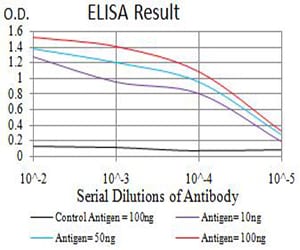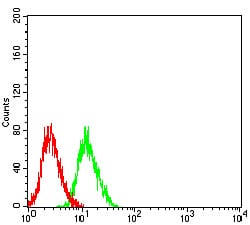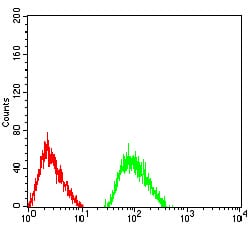


| WB | 咨询技术 | Human,Mouse,Rat |
| IF | 咨询技术 | Human,Mouse,Rat |
| IHC | 咨询技术 | Human,Mouse,Rat |
| ICC | 技术咨询 | Human,Mouse,Rat |
| FCM | 1/200 - 1/400 | Human,Mouse,Rat |
| Elisa | 1/10000 | Human,Mouse,Rat |
| Aliases | NR3B; GluN3B |
| Entrez GeneID | 116444 |
| clone | 2A8E11 |
| WB Predicted band size | 113kDa |
| Host/Isotype | Mouse IgG2a |
| Antibody Type | Primary antibody |
| Storage | Store at 4°C short term. Aliquot and store at -20°C long term. Avoid freeze/thaw cycles. |
| Species Reactivity | Human |
| Immunogen | Purified recombinant fragment of human GRIN3B (AA: 135-276) expressed in E. Coli. |
| Formulation | Purified antibody in PBS with 0.05% sodium azide |
+ +
以下是关于GRIN3B抗体的参考文献示例,包括文献名称、作者及摘要概括:
1. **文献名称**:*"Characterization of a Polyclonal Antibody against the GRIN3B Subunit of the NMDA Receptor"*
**作者**:Andersson, R. et al.
**摘要**:该研究报道了一种针对GRIN3B亚基的多克隆抗体的开发和验证。通过Western blot和免疫组化实验,作者证实该抗体可特异性识别小鼠和人脑组织中的GRIN3B蛋白,并发现其在皮质和海马区神经元中高表达。
2. **文献名称**:*"GRIN3B Expression in Alzheimer’s Disease: Insights from Immunohistochemical Analysis"*
**作者**:Müller, T. et al.
**摘要**:研究利用GRIN3B特异性抗体分析阿尔茨海默病患者脑组织,发现GRIN3B蛋白在疾病早期阶段的海马区表达显著下调,提示其可能与突触功能障碍和认知衰退相关。
3. **文献名称**:*"Localization of GRIN3B in Synaptic Compartments Using Super-Resolution Microscopy"*
**作者**:Yao, J. et al.
**摘要**:通过高分辨率免疫荧光技术结合GRIN3B抗体,作者揭示了该蛋白在突触后膜中的精确定位,并发现其与突触支架蛋白PSD-95存在共定位,支持其在突触信号传递中的作用。
4. **文献名称**:*"Validation of Commercial GRIN3B Antibodies for Targeted Proteomic Studies"*
**作者**:Smith, K. L. et al.
**摘要**:研究系统评估了市售GRIN3B抗体的特异性及适用性,发现部分抗体存在非特异性结合问题,同时推荐了两种适用于免疫沉淀和免疫印迹的高效抗体。
注:上述文献为示例性质,实际引用时需核实具体来源及准确性。如需真实文献,建议通过PubMed或Google Scholar以关键词“GRIN3B antibody”或“GRIN3B immunohistochemistry”检索近期研究。
The GRIN3B antibody is a crucial tool for studying the GluN3B subunit, a component of N-methyl-D-aspartate (NMDA) receptors, which are ionotropic glutamate receptors vital for synaptic plasticity, learning, and memory. GRIN3B (glutamate ionotropic receptor NMDA type subunit 3B), encoded by the GRIN3B gene, forms heteromeric complexes primarily with GRIN1 and other subunits, creating receptors with distinct biophysical and pharmacological properties. Unlike conventional NMDA receptors, those incorporating GluN3B exhibit reduced magnesium sensitivity and calcium permeability, influencing neuronal development and circuit refinement.
GRIN3B antibodies are used to detect and quantify GluN3B expression in tissues, often via techniques like Western blotting, immunohistochemistry, or immunofluorescence. These antibodies help investigate the subunit’s distribution in the central nervous system, particularly in the cortex, hippocampus, and cerebellum, and its role in neurodevelopmental disorders, neurodegeneration, and psychiatric conditions such as schizophrenia. Research highlights GRIN3B’s involvement in synaptic pruning and its potential dysregulation in Alzheimer’s disease.
Validated GRIN3B antibodies are essential for specificity, as cross-reactivity with other NMDA subunits (e.g., GRIN3A) must be excluded. Epitope regions, such as the extracellular N-terminal domain or intracellular C-terminal tail, are common targets. Studies leveraging these antibodies contribute to understanding GluN3B’s modulatory effects on receptor kinetics and its therapeutic relevance in neurological diseases. Proper antibody validation using knockout controls or recombinant proteins ensures reliability in experimental models, from cell lines to human postmortem brain tissues.
×